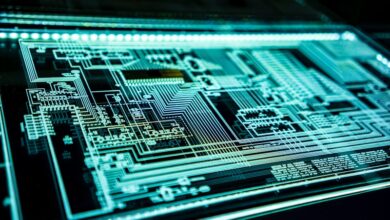3D Printing Revolutionizes Manufacturing Processes

As technology continues to advance at a rapid pace, one groundbreaking innovation that has revolutionized manufacturing processes is 3D printing. This cutting-edge technology has brought about a paradigm shift, fundamentally changing the way products are designed, prototyped, and manufactured. In this article, we will explore the incredible impact of 3D printing on the manufacturing industry.
Gone are the days when traditional manufacturing methods required complex molds, lengthy production cycles, and substantial material waste. With 3D printing, also known as additive manufacturing, objects are created layer by layer from a digital model. This enables businesses to produce intricate designs and customized products with unparalleled precision and speed.
One of the key advantages of 3D printing lies in its ability to reduce costs. Traditional manufacturing often involves high setup costs for tooling and molds. However, 3D printing eliminates the need for these expensive tools, allowing manufacturers to save both time and money. By directly fabricating products from digital files, companies can eliminate excess inventory and reduce material waste, leading to significant cost reductions throughout the production process.
Moreover, 3D printing empowers designers and engineers to push the boundaries of creativity. It allows them to experiment with complex geometries and create highly intricate prototypes that were previously impractical or impossible to achieve. This level of design freedom opens up a world of possibilities, enabling innovation and pushing product development to new heights.
The versatility of 3D printing extends beyond prototyping. It has now become a viable method for small-scale production and customization. Companies can quickly iterate and refine their designs without the constraints of traditional manufacturing processes. From aerospace components to medical implants and consumer goods, the applications of 3D printing span across various industries, transforming the way products are made, delivered, and consumed.

The advent of 3D printing has ushered in a new era of manufacturing. With its ability to reduce costs, enable intricate designs, and facilitate customization, 3D printing has proven itself to be a game-changer for the industry. As this technology continues to evolve and become more accessible, we can expect even greater advancements and innovations in the world of manufacturing. The future is undoubtedly exciting as 3D printing reshapes the way we create and produce objects.
Unleashing the Future: How 3D Printing is Revolutionizing Manufacturing Processes
Imagine a world where you can turn your wildest ideas into physical objects with just a push of a button. A world where manufacturing processes are no longer bound by traditional limitations and creativity knows no bounds. Welcome to the era of 3D printing, a groundbreaking technology that is revolutionizing the way we manufacture goods.
At its core, 3D printing, also known as additive manufacturing, is a process of creating three-dimensional objects by adding layer upon layer of material. It’s like building a structure from the ground up, but instead of bricks or concrete, it utilizes materials such as plastic, metal, or even biological matter. This game-changing technology has the potential to reshape various industries, from healthcare to automotive, and everything in between.
One of the most remarkable aspects of 3D printing is its versatility. It allows for the production of highly complex structures that were previously impossible to create using traditional manufacturing methods. Intricate designs, geometries, and interlocking parts can now be effortlessly brought to life. Whether it’s a customized prosthetic limb tailored to fit an individual’s unique anatomy or a lightweight yet sturdy aerospace component, 3D printing opens up a world of possibilities.
Not only does 3D printing enable the production of intricate designs, but it also offers significant cost and time savings. Traditional manufacturing often involves time-consuming processes such as machining or molding, which require expensive tooling and manual labor. With 3D printing, these barriers are eliminated. The technology allows for the rapid production of prototypes, reducing development cycles and enabling faster iterations. This agility empowers designers and engineers to test ideas quickly, refine their designs, and bring products to market at an accelerated pace.
Furthermore, 3D printing promotes sustainability and reduces waste. Traditional manufacturing methods often result in excess material being discarded during the production process. In contrast, 3D printing only uses the exact amount of material required to build the desired object, minimizing waste and reducing environmental impact. Additionally, the ability to produce spare parts on demand reduces the need for large inventories, leading to more efficient supply chains and lower storage costs.
3D printing is revolutionizing manufacturing processes by unlocking unprecedented levels of creativity, streamlining production cycles, saving costs, and promoting sustainability. Its potential applications are vast, ranging from healthcare and aerospace to fashion and consumer goods. As this groundbreaking technology continues to evolve, we can expect a future where the impossible becomes possible, and innovation knows no bounds.
From Blueprint to Reality: Exploring the Transformative Power of 3D Printing in Manufacturing
Have you ever wondered how a simple blueprint can transform into a tangible reality? Well, let’s dive into the captivating world of 3D printing in manufacturing and unveil its transformative power. Strap in, because we’re about to embark on an extraordinary journey where imagination meets innovation.
Picture this: you have an intricate design in mind, but turning it into a physical object seems like an arduous task. This is where 3D printing comes to the rescue, offering a revolutionary solution. Using this technology, manufacturers can bring their ideas to life with astonishing precision and efficiency.
But what exactly is 3D printing? At its core, it’s a process of creating three-dimensional objects by adding layer upon layer of material. Imagine building a structure one brick at a time, except in this case, the bricks are meticulously crafted layers of material, often plastics or metals. These layers gradually stack up, forming a solid object that replicates the original design flawlessly.
The impact of 3D printing in the manufacturing industry cannot be overstated. It has revolutionized prototyping by significantly reducing time and cost. Previously, creating prototypes involved intricate and time-consuming processes, but with 3D printing, it has become a breeze. Manufacturers can now quickly produce prototypes, allowing for faster iterations and improvements.
Moreover, this technology enables customization on an unprecedented scale. Instead of relying on mass production, where each product is identical, 3D printing empowers manufacturers to tailor their creations to specific needs. Whether it’s personalized medical implants or customized automotive parts, the possibilities are virtually limitless.



Let’s not forget the environmental benefits of 3D printing. By minimizing waste and optimizing material usage, this technology promotes sustainability in manufacturing. Traditional methods often result in excess material being discarded, but with 3D printing, resources are utilized more efficiently, leading to a greener and more eco-friendly production process.

The transformative power of 3D printing in manufacturing is awe-inspiring. From turning blueprints into reality to revolutionizing prototyping and enabling customization, this technology has truly changed the game. It’s time to embrace this remarkable innovation and witness firsthand how it shapes the future of manufacturing. So, are you ready to embark on this remarkable journey of creation?
Innovative Paradigm Shift: How 3D Printing is Reshaping Traditional Manufacturing Methods
Innovation has always been the driving force behind progress, revolutionizing the way we live and work. One such groundbreaking advancement that is causing a seismic shift in traditional manufacturing methods is 3D printing. This cutting-edge technology has taken the world by storm, captivating industries with its limitless potential.
So, what exactly is 3D printing? Imagine having the power to transform a digital design into a physical object with just the touch of a button. That’s precisely what 3D printing offers. It utilizes additive manufacturing techniques, layering materials on top of one another to create three-dimensional objects. This process eliminates the need for molds or extensive tooling, streamlining production and reducing costs significantly.
The impact of 3D printing is nothing short of astounding. With this technology at their disposal, manufacturers can now bring their concepts to life rapidly. Complex geometries that were once deemed impossible to produce are now achievable with ease. From intricate prototypes to custom parts, 3D printing provides unparalleled freedom and flexibility.
Moreover, 3D printing enables efficient resource utilization. Traditional manufacturing often results in significant material wastage due to subtractive processes. In contrast, 3D printing optimizes material usage by only adding the necessary amount, minimizing waste and environmental impact. This eco-friendly approach aligns with our growing focus on sustainability.
The healthcare industry is particularly benefiting from this innovative paradigm shift. Customized prosthetics, patient-specific implants, and anatomical models for surgical planning are now within reach thanks to 3D printing. This technology empowers medical professionals to enhance patient care, offering tailored solutions that improve both treatment outcomes and quality of life.
Furthermore, 3D printing isn’t limited to a single industry. It is transforming aerospace, automotive, fashion, and even the culinary arts. The possibilities are endless, limited only by our imagination. As 3D printers become more accessible and affordable, small businesses and individuals can also harness this technology, spurring creativity and entrepreneurship.
3D printing is revolutionizing traditional manufacturing methods by introducing a new era of efficiency, customization, and sustainability. Its ability to quickly produce complex objects and optimize material usage is reshaping industries across the board. From healthcare advancements to unleashing creativity on an unprecedented scale, 3D printing is undoubtedly leaving an indelible mark on our world. The only question that remains is: what will we create next?
Breaking Boundaries: The Rise of 3D Printing and its Impact on Industrial Production
Imagine a world where you can transform your ideas into physical reality with just a few clicks. A world where objects materialize before your eyes, layer by layer, defying traditional manufacturing limitations. Welcome to the realm of 3D printing, an innovation that is revolutionizing industrial production and pushing boundaries like never before.
So, what exactly is 3D printing? At its core, it is a process of creating three-dimensional objects from digital designs by adding material layer upon layer. Unlike traditional manufacturing methods that involve subtracting material through cutting or shaping, 3D printing, also known as additive manufacturing, builds objects from the ground up. It’s like constructing a building one brick at a time, but in this case, the bricks are microscopic layers of material.
This technology is captivating industries worldwide due to its immense potential. From aerospace and automotive to healthcare and fashion, 3D printing offers a level of customization and agility that was once unimaginable. Need a prototype for a new product? No problem. Want to personalize medical implants for patients? Consider it done. 3D printing allows for intricate designs, complex geometries, and rapid prototyping, empowering businesses to bring their ideas to life faster than ever before.
The impact of 3D printing on industrial production is nothing short of remarkable. Traditional manufacturing often requires expensive molds, tooling, and lengthy setup times. With 3D printing, these constraints are shattered. The technology enables on-demand production, eliminating the need for large inventories and reducing waste. Combined with the ability to create lightweight structures and optimize material usage, 3D printing provides cost-efficiency unparalleled by conventional methods.
Moreover, 3D printing opens doors to innovative design possibilities. Engineers and designers are no longer limited by the constraints of traditional manufacturing processes. They can explore intricate shapes and organic structures that were previously impractical or impossible to produce. This newfound freedom fuels creativity and unleashes a wave of innovation, enabling breakthroughs across industries.
The rise of 3D printing is breaking boundaries and transforming industrial production as we know it. It empowers businesses with unprecedented levels of customization, agility, and cost-efficiency. From prototypes to final products, this technology has the potential to reshape manufacturing processes across various sectors. As we delve further into this exciting era, one thing is for certain: 3D printing will continue to shape our world in unimaginable ways.




